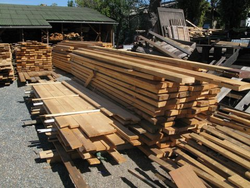Wood choice
In period, some furniture was made with sawn and dried wood, some with green, riven wood. Some with a mixture of both. It's basically impossible to tell which without examining the piece carefully. Occasionally we'll get some good inside or back pictures that give us some clues. There are also some vernacular forms that were pretty much always made green. High-status items were usually made with the best materials available.
Check out my Green vs. Dried Wood article for more details on the difference.
Almost all of my furniture projects are made with air-dried or kiln-dried sawn lumber. This is for two reasons: 1) I live in suburbia and obtaining a good green log is problematic and 2) my shop time is highly variable.
A log suitable for riving needs to be pretty large. Your largest board will be about 40% of the diameter of the log it's split from. So, it needs to be roughly 20"-24" in diameter to give you reasonable size boards. Secondly, it has to be really straight with no branches. Otherwise, it will be hard to split and the resulting boards will be very twisty and require you to plane away a lot of material getting something you can use. These trees grow in a real forest, not someone's yard.
Yard trees are notorious for their defects. In addition to nails and other metal objects potentially embedded in them, they are subject to a lot of stress from the wind and grow more open due to the available sunlight. So it grows broadly, gets blown around a lot, and may have BBs, nails, etc. This makes crappy boards.
It's not uncommon for months to go by between projects so unless some green wood becomes available at just the right time, it will dry out too much before I can work it.
I am much more interested in a quality item than a slavish period production process, so I use dried wood. When I retire and move to the country green woodworking will become a viable option.
My lumber is sourced from two places:
- Auctions - I attend personal property auctions in the nearby rural areas to buy tools for my tool business, sometimes these include rough lumber as well. If it's a good deal, I buy some and stash it in my shed. It's is usually a pretty good deal. Usually, they are from trees on the property or nearby so it's mostly red/white oak, walnut, and cherry. Cut at a local mill or mobile mill and air-dried. Quality runs the gamut, but it's cheap.
- Local lumber yard - If I need something specific that's not in the lumber shed already, it's off to the lumber yard. Almost always this will be kiln-dried commercially harvested wood. So the quality is high, as is the price. Almost anything that's still commercially harvested is available.
- Portable Saw Mill - If you know someone with a small mill, these are trailer mounted or ground mounted band saw on track things, you are in luck. If you can source logs, perhaps from a tree service, and get them to the mill or have them delivered, you can get it cut to your specifications (quartersawn, thicker sizes like 8/4, etc.).
You'll have to cart the lumber home and dry it yourself, but that's not exactly hard. There are instructions all over the net for air-drying lumber or building little backyard solar kilns even if you'd rather not wait the year per inch of thickness that's the rule of thumb for air drying.
I've done this in the past and it worked great. I air dried the boards in my basement (back when it wasn't much more than a storage area).
Greenwood Options
If your heart is set on using greenwood, and you live in suburbia hell as I do, your best bet is to contact local tree companies. In these areas, the tree companies have to pay to dump wood at the county dump. We use them for wood chips once or twice a year.
Half of our back yard is fenced in for the dogs to run in. Dogs are hard on the grass and it was hard enough to get grass to grow in the first place since we have mature trees. So we spread wood chips across the whole thing to about 4"-6" deep. Drains great, looks good, doesn't smell. They rot down, so you need to add a layer periodically.
A lot of people will take chips, so the companies all keep lists of people that will take it and they call you if they are in your area and you're on the list. They have few takers for the wood. I had to take a load once to get the chips, but it was a PITA. The "firewood" they dropped was 3' in diameter and maple, which doesn't rive.
Kiln-dried lumber
Kiln-dried lumber comes with a caveat, more than just price. If it was dried too rapidly, the board may be case-hardened. That occurs when the outer shell dries so rapidly, it shrinks against the inner core slowing its moisture loss. As the core dries and attempts to shrink accordingly, that movement is resisted by the already set outer core. With the outer shell in compression stress and the inner part in tension, things could get very exciting when you saw the board. Even if catastrophic warping or splitting doesn't occur during cutting, the sawn parts are liable to warp or twist over the next day or so. If you think you have wood in such a state, cut the pieces larger than needed so you can correct any movement and still have a large enough piece left.
Case-hardened wood is really a bear for carving as well. Something like oak is already hard enough to carve dry. Case-hardened oak will make you question your choice of hobbies and consider arson or something instead.
